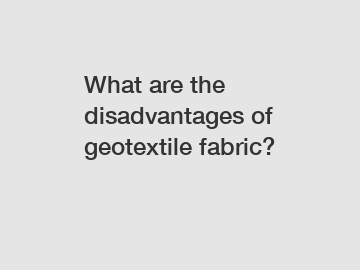What are the disadvantages of geotextile fabric?
Geotextile fabric is a commonly used synthetic material in various civil engineering applications. It is designed to have a wide range of benefits, including soil stabilization, erosion control, and filtration. However, like any product, geotextile fabric also has its disadvantages that need to be considered. In this article, we will explore the limitations and drawbacks associated with geotextile fabric.
1. Limited Tensile Strength.
Geotextile fabric is primarily used to reinforce soil and provide stability. However, it has a relatively limited tensile strength compared to other geosynthetic materials like geogrids or geocells. This means that in high-stress situations or applications where significant tensile forces are expected, geotextile fabric may not be the most suitable choice. Engineers and designers must carefully assess the expected loads and select an appropriate reinforcement material accordingly.

2. Vulnerability to Ultraviolet (UV) Radiation.
Another major disadvantage of geotextile fabric is its vulnerability to UV radiation. When exposed to sunlight for extended periods, the fabric can deteriorate and lose its strength and effectiveness. This poses a significant drawback in applications where the fabric is exposed to direct sunlight, such as in landscaping projects or on slopes. To mitigate this issue, designers may need to opt for UV-resistant geotextiles or consider using additional protective layers.
3. Clogging and Reduced Permeability.
Geotextile fabrics with fine pores are used to allow water to flow through while preventing fine particles from passing through. However, these fine pores can become clogged with sediment or debris over time, reducing the permeability of the fabric. This clogging can lead to localized drainage problems and reduced effectiveness of the geotextile in filtration applications. Regular maintenance and inspection are necessary to ensure that the fabric remains unclogged and functions properly.
4. Incompatibility with Certain Soils.
Geotextile fabrics typically work well with granular or coarse soils by stabilizing them and preventing erosion. However, in certain types of cohesive soils like clays or silts, the fabric may not bond adequately. This can result in the geotextile fabric losing its effectiveness and failing to provide the desired soil stabilization. In such cases, engineers may need to consider alternative geosynthetic materials or modify the design approach to address the soil's properties.
5. Installation Challenges.
Installing geotextile fabric requires careful planning and expertise. If not properly installed, the fabric may develop wrinkles, folds, or gaps, compromising its functionality. Additionally, poor installation practices can result in the fabric shifting or tearing during construction or over time. This can significantly impact the performance of the geotextile and may require expensive repairs or replacements.
In conclusion, geotextile fabric offers several advantages in civil engineering applications. However, it is essential to consider its limitations and drawbacks. Engineers and designers must carefully evaluate the project requirements, soil properties, and potential stress loads before selecting geotextile fabric as the appropriate solution.
To learn more about geotextile fabric and its suitability for specific applications, please contact us. Our team of experts will be happy to assist you with your inquiries and provide guidance on the best geosynthetic solutions for your project.
Want more information on geotube, trp geomembranes, difference between woven and non woven geotextile? Feel free to contact us.


